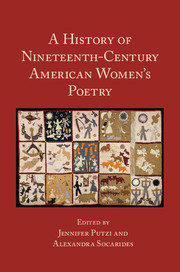Book contents
- Frontmatter
- Contents
- List of Illustrations
- List of Contributors
- Acknowledgments
- Introduction: Making History: Thinking about Nineteenth-Century American Women's Poetry
- PART I 1800–1840, AMERICAN POESIS AND THE NATIONAL IMAGINARY
- PART II 1840–1865, UNIONS AND DISUNIONS
- 8 Women, Transcendentalism, and The Dial: Poetry and Poetics
- 9 Poets of the Loom, Spinners of Verse: Working-Class Women's Poetry and The Lowell Offering
- 10 Women's Transatlantic Poetic Network
- 11 Making and Unmaking a Canon: American Women's Poetry and the Nineteenth-Century Anthology
- 12 “What witty sally”: Phoebe Cary's Poetics of Parody
- 13 Nineteenth-Century American Women's Poetry of Slavery and Abolition
- 14 Fever-Dreams: Antebellum Southern Women Poets and the Gothic
- 15 The Civil War Language of Flowers
- 16 Poetry and Bohemianism
- PART III 1865–1900, EXPERIMENT AND EXPANSION
- Suggested Further Reading
- Index
16 - Poetry and Bohemianism
from PART II - 1840–1865, UNIONS AND DISUNIONS
Published online by Cambridge University Press: 21 January 2017
- Frontmatter
- Contents
- List of Illustrations
- List of Contributors
- Acknowledgments
- Introduction: Making History: Thinking about Nineteenth-Century American Women's Poetry
- PART I 1800–1840, AMERICAN POESIS AND THE NATIONAL IMAGINARY
- PART II 1840–1865, UNIONS AND DISUNIONS
- 8 Women, Transcendentalism, and The Dial: Poetry and Poetics
- 9 Poets of the Loom, Spinners of Verse: Working-Class Women's Poetry and The Lowell Offering
- 10 Women's Transatlantic Poetic Network
- 11 Making and Unmaking a Canon: American Women's Poetry and the Nineteenth-Century Anthology
- 12 “What witty sally”: Phoebe Cary's Poetics of Parody
- 13 Nineteenth-Century American Women's Poetry of Slavery and Abolition
- 14 Fever-Dreams: Antebellum Southern Women Poets and the Gothic
- 15 The Civil War Language of Flowers
- 16 Poetry and Bohemianism
- PART III 1865–1900, EXPERIMENT AND EXPANSION
- Suggested Further Reading
- Index
Summary
The February 6, 1864, issue of the New York Illustrated News included two artist's renditions of the nightly revels at Charles Pfaff's beer cellar, the saloon that had become famous as the gathering place of the United States’ first self-described bohemian literary community. In the first image, a promiscuous gathering of men and women fills the air with pipe and cigar smoke as alcohol flows freely and all but one of the women in the picture find themselves in the amorous embraces of lusty bohemian men. In the second image, the men are alone, the air is virtually smoke-free, and a single bottle of wine sits on a table covered with literary works-in-progress as male writers soberly discuss their art in an environment free from the distracting presence of women [Fig. 12 & Fig. 13]. Period sources differ as to what actually took place on an average night at Pfaff's during its heyday from the late 1850s till the end of the Civil War, with some claiming it to be a site of intellectual discussion of the highest order, and others, such as an unpublished poem by Walt Whitman, describing it as a place “where the drinkers and laughers meet to eat and drink and carouse.” The debate was not local to the Pfaff's bohemians. As both Daniel Cottom and Joanna Levin have recently shown, following Henry Murger's popular account of the bohemians of Paris's Latin Quarter in his Scènes de la vie de bohème (1851), “the bohemian” became a contested figure whose values and ideologies were claimed by different groups for a range of purposes throughout the nineteenth century and across the Atlantic world. Regardless of the various meanings ascribed to bohemianism in the nineteenth century, women poets played an integral role in defining what bohemia could (and could not) mean for emerging conceptions of the American counterculture, as well as for the discourse surrounding women's rights.
In 1860, Ada Clare, a Pfaff's regular and the universally acknowledged “Queen of Bohemia,” defended the figure of the bohemian against charges that this new, French-derived social type “must take pleasure in keeping his boots and cheese in the same drawer,” insisting instead that “the principles of good taste and feeling” always guided the bohemian revolt against traditional manners and mores.
- Type
- Chapter
- Information
- A History of Nineteenth-Century American Women's Poetry , pp. 264 - 280Publisher: Cambridge University PressPrint publication year: 2016

